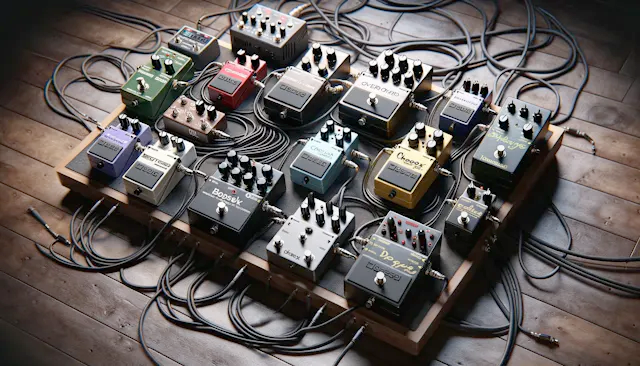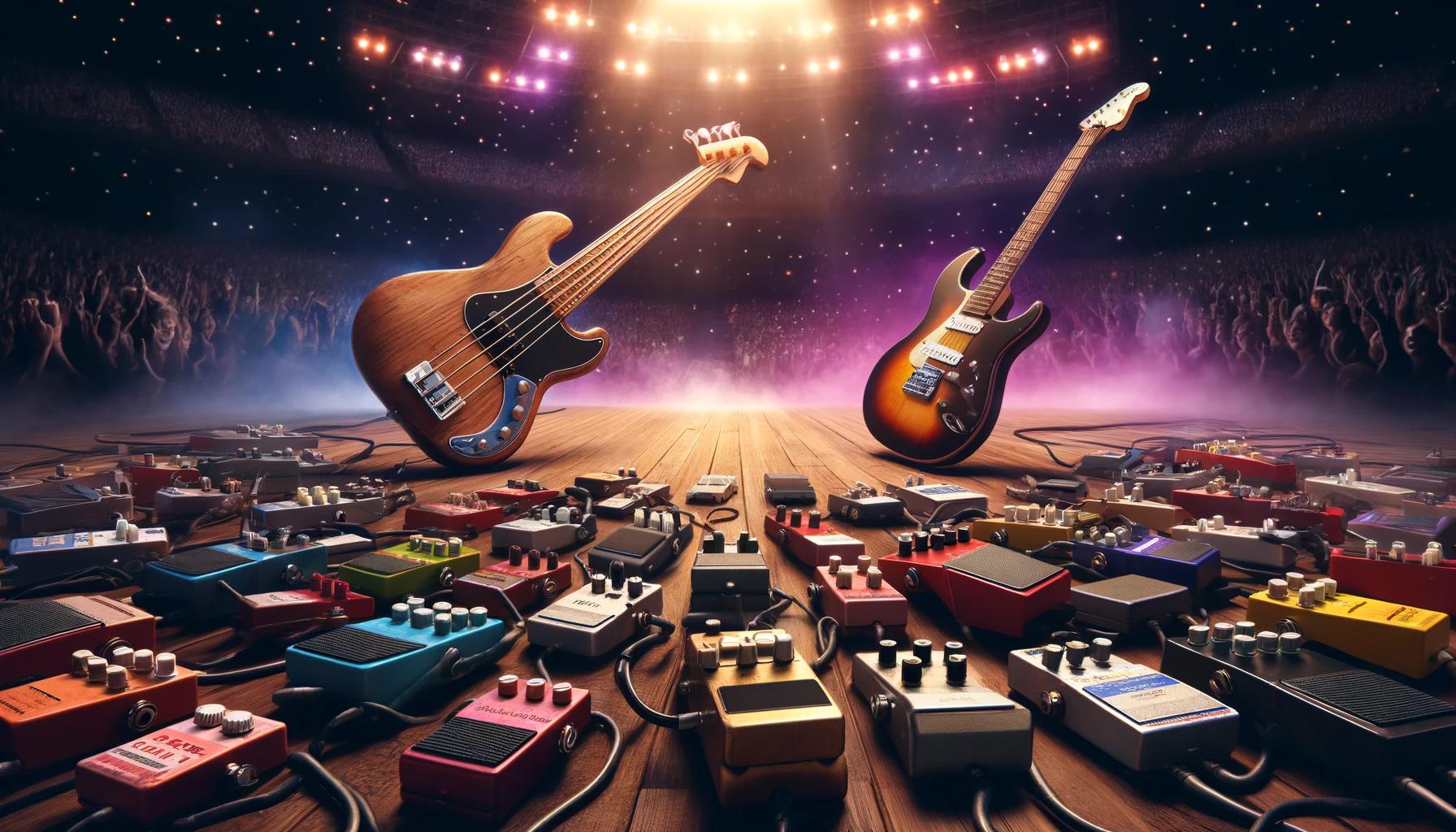
 Anthony Easton
Anthony Easton
Have you ever gazed at your guitar player's pedal collection and wondered if those same pedals could take your bass playing to uncharted territories? You're not alone. The question of whether guitar pedals can be effectively used with a bass guitar is a question as old as the strings on your bass are now (but seriously, we all need to change our strings more often).
While the short answer is that, yes, you can use guitar pedals with bass guitars easily, there's some other important things to consider.
The primary technical difference between guitar and bass pedals lies in their frequency range optimization. Guitar pedals are engineered to accentuate mid to high frequencies, catering to the guitar's tone. In contrast, bass pedals focus on preserving low-end frequencies essential for maintaining the bass's character in a mix.
The differentiation in frequency optimization between these pedal types is not merely a matter of technicality but a reflection of the instruments' unique roles in music. Guitarists seeking to use pedals designed for bass, or vice versa, must be aware of how these frequency-focused designs can affect their sound. For example, a guitar pedal might inadvertently diminish the bass's impact by not adequately supporting its lower frequencies, potentially leaving the mix feeling hollow.
Beyond frequency considerations, the concept of impedance matching emerges as another critical technical difference. Impedance, measured in ohms, represents the resistance to the flow of an electrical signal. Each pedal, instrument, and amplifier has its own impedance level, and mismatches in this area can lead to various audio issues, including tone loss or the introduction of unwanted noise.
For guitarists and bassists alike, understanding the importance of impedance matching is key to maintaining the integrity of their tone. When a pedal designed for a guitar, which typically has a higher impedance, is used with a bass, the mismatch can result in a weakened signal. This weakening not only affects volume but can also diminish the clarity and fullness of the tone.
The impact on the signal chain is also significant. The signal chain—the order in which effects pedals are arranged—plays a pivotal role in shaping the final sound. Impedance mismatches can alter the effectiveness of this chain, changing how each pedal interacts with the others. For bass players using guitar pedals, this might mean rethinking their signal chain to accommodate the differences in impedance, ensuring that the signal remains strong and clear throughout the chain.
The fusion of guitar pedals with bass equipment isn't just about crossing wires between instruments—it's about crossing frontiers in soundscapes and musical creativity. This blending can offer distinct advantages, enriching both the playing experience and the resultant audio expression.
At the heart of music lies the pursuit of expression, and what better way to enhance expression than by broadening your array of sonic colors? Guitar pedals, with their wide variety of effects, offer bassists an expansive toolkit for creativity. These effects range from the ethereal sweeps of phasers and flangers to the gritty textures of fuzz and distortion pedals, each providing a unique flavor that can significantly alter or embellish the bass line's impact within a composition.
For bass players, the allure of using guitar pedals lies in their ability to introduce effects that are not traditionally associated with bass lines, thereby breaking conventional boundaries. For instance, a delay pedal, while commonly used with guitars for creating echoes and atmospheric soundscapes, can be equally captivating when applied to bass. It can transform simple bass lines into rhythmic patterns that add depth and complexity to the music. Similarly, reverb pedals can give the bass a sense of space and dimension, making it feel more alive and dynamic within the mix.
The use of guitar pedals in a bass context not only diversifies the bassist's toolkit but also encourages experimental approaches to music-making. This exploration can lead to discovering new textures and techniques that define a musician's signature sound, setting their work apart from the conventional.
Beyond the artistic benefits, the pragmatic aspect of using guitar pedals for bass cannot be understated. Many musicians, especially those in the early stages of their careers, operate within tight budget constraints. In such scenarios, the ability to repurpose guitar pedals for bass becomes not just an artistic choice but a financially sound one.
The versatility of guitar pedals means that a single pedal can serve multiple roles across different instruments, negating the need to purchase duplicate effects for each. This versatility is especially beneficial for multi-instrumentalists who can seamlessly integrate their pedal collection across their guitar and bass setups, ensuring a consistent palette of sounds regardless of the instrument in play.
Moreover, this approach allows bassists to experiment with a broad range of effects without the immediate pressure of investing in new, possibly expensive, bass-specific pedals. It opens the door to creative experimentation and personal growth as a musician, without the financial burden typically associated with expanding one’s musical gear.
Embracing guitar pedals for bass ventures introduces a tapestry of sonic possibilities but not without its share of challenges and considerations. Addressing these hurdles is key to ensuring that the fusion of guitar and bass gear enhances rather than detracts from the music.
One of the most pronounced challenges when integrating guitar pedals into a bass setup is the potential loss of low-end clarity. The essence of the bass lies in its ability to provide a solid foundation for a piece, with its low frequencies anchoring the harmonic structure. However, many guitar pedals are designed with a focus on mid to high frequencies, which can sometimes lead to the attenuation of the bass's crucial low-end when such pedals are used indiscriminately.
The risk of muddiness arises when these pedals compress or distort the signal in a way that obscures the distinctiveness of the bass notes, causing them to blend into a less coherent low-frequency mass. This can particularly be an issue in live settings, where the clarity of each instrument is paramount to the overall sound quality.
Mitigating this issue involves a combination of pedal selection and setting adjustments. Bassists are advised to experiment with the pedal's tone controls, if available, to find a setting that preserves the low-end while still achieving the desired effect. Additionally, using pedals that include a blend feature, which allows the original signal to be mixed with the effected signal, can help maintain clarity by keeping the core bass tone intact.
Ensuring compatibility between guitar pedals and bass equipment goes beyond just tweaking knobs; it often requires a holistic view of how these tools fit into the larger signal chain. Adapting guitar pedals for bass use might necessitate adjustments such as reordering the pedals to optimize signal flow or employing additional devices like EQ pedals to restore any lost frequencies.
Understanding the inherent characteristics of each pedal and how it interacts with the bass signal is crucial. For example, a pedal with a pronounced mid-boost might be more suitably placed after a compressor in the chain to prevent it from overpowering the bass's natural tone. Similarly, experimentation with pedal settings is essential to find the sweet spot where the effect enhances rather than overwhelms the bass sound.
Despite the challenges, many guitar pedals can indeed complement a bass setup remarkably well when chosen and used thoughtfully.
Fuzz, distortion, and overdrive pedals offer a spectrum of harmonic richness that can add a compelling layer to bass lines. When selecting these pedals for bass, it's important to look for options that retain clarity at lower frequencies or offer a blend control. This allows bassists to dial in the right amount of grit without sacrificing the instrument's depth and power. Pedals designed with a wider frequency response or specific "bass-friendly" models can provide the desired drive while keeping the low end intact.
Modulation and delay effects, traditionally used by guitarists to add depth and movement to their sound, can also bring an innovative dimension to bass playing. These pedals can transform straightforward bass lines into ambient landscapes or rhythmic patterns that enhance the song's texture. Selecting pedals that allow for subtle modulation or delay settings can help ensure that the effect complements rather than competes with the bass's role. Moreover, pedals that include separate controls for dry and wet signals are particularly valuable, as they enable bassists to maintain the foundation of their tone while weaving in complex effects.
Navigating the integration of guitar pedals into a bass rig requires a blend of artistry and technical know-how. By considering strategic pedalboard setup and fine-tuning pedal settings, bassists can ensure that their venture into using guitar effects enhances their sound rather than compromising it.
The pedalboard setup is fundamental in creating a seamless integration of guitar pedals into your bass signal chain. The goal is to maintain signal integrity and ensure each pedal can perform optimally without interfering with the bass’s natural tone. Here are key considerations:
After setting up your pedalboard with careful consideration of signal flow and technical compatibility, the next step is fine-tuning each pedal to ensure it complements the bass frequencies effectively:
By adopting these practical tips for setting up your pedalboard and fine-tuning your pedal settings, you can successfully incorporate guitar pedals into your bass rig. This approach not only broadens your tonal palette but also ensures that your bass retains its fundamental role in the music, providing a solid foundation while exploring new sonic territories.
Check out the latest news and articles from around the pedal world.

 Anthony Easton
Anthony Easton
 Anthony Easton
Anthony Easton
 Anthony Easton
Anthony Easton
 Anthony Easton
Anthony Easton
 Anthony Easton
Anthony Easton
 Anthony Easton
Anthony Easton
 Anthony Easton
Anthony Easton
 Anthony Easton
Anthony Easton
 Anthony Easton
Anthony Easton
 Anthony Easton
Anthony Easton
 Anthony Easton
Anthony Easton